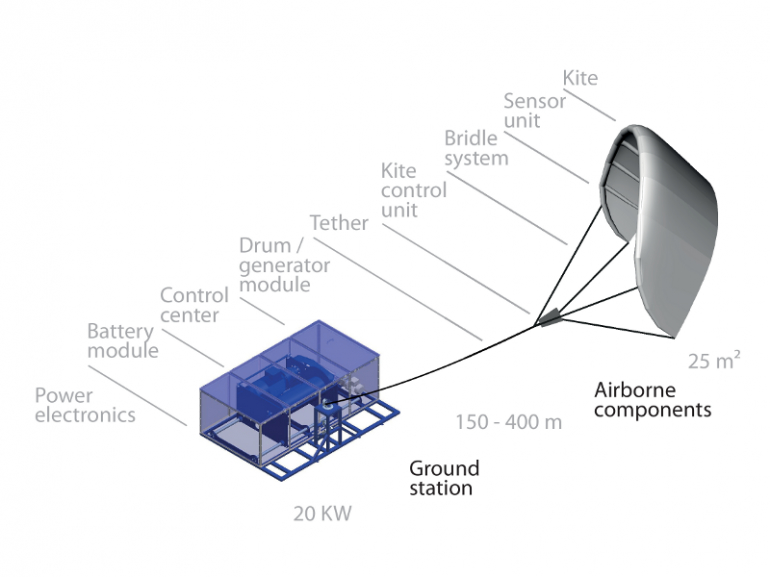When thinking of harvesting energy from the wind, wind turbines appear as the widespread solution. But what about kites as a renewable energy source?
What is it about? ‘Crosswind kite power’ or ‘Airborne Wind Energy’ consists of a light aerodynamic flying device which receives energy from the wind and transports it via cables to a ground station, where there is a generator module that converts this mechanical energy into electricity. The system operates in ‘periodic pumping cycles’ [1]: when reaching the maximum allowed length of cable the kite changes its orientation with respect to wind, gliding back down allowing the rope to be rolled up again. Automatic control technology is crucial to synchronize generator and kite and to keep the forces between established limits.
What are the advantages with respect to wind turbines?
- Kites can access higher altitudes, where there is stronger and more continuous wind. The higher the wind speed, the higher the wind energy that can be turned into electricity. As an example: at 80 meters from the ground the wind speed is almost 5 m/s while at 800 meters high, the wind speed raises to 7 m/s [2], so at 800 meters the extracted power could be four times higher. According to the Italian firm KiteGen [3]: ‘a configuration with 100 megawatts of peak capacity allows production of 500 gigawatt-hours per year, enough to supply 86,000 households’. Huge potential for regions with high speed jet streams, as the Netherlands!
- Kites generate cost-effective electricity, due to higher speed and lower torque than wind turbines. According to [3], ‘KiteGen estimates that a 100-megawatt plant would produce electricity at a cost of about 0.03 euros/KWh’, lower than current wind turbines
- Kites use flexible lightweight materials. They are lighter and more maneuverable than wind turbines. The heavy generator is positioned on the ground, reducing the structural forces and the need of a bending-resistant base or ‘foundation’ – particularly interesting for offshore applications. As a result, kites do not use the big amounts of concrete and steel that wind turbines need for the construction of their foundation and tower and blades so they have less material energy intensity
- Kites have a lower environmental impact. Due to the higher altitudes and the kites’ tensile structure, the landscape is less visually damaged. Noise emissions from the rotor blades in wind turbines and potential accidents with birds could also be better avoided. Essential for a touristic island as Texel!
- Kites have higher portability and modularity. They can be more easily disassembled and transported to a new site for deployment. Additionally, the generator and power electronics are at ground level, which allows more convenient and safer operation and maintenance.
What are the challenges to penetrate and upscale in the market? There are technical challenges mainly regarding the automatic flight control system, but also the optimization of lightweight materials, aerodynamics and general layout (e.g. several kites in tandem) to obtain higher power outputs. However, as a socio-technical system the hurdles to become a mainstream source of electricity are beyond technical ‘immaturity’! Regulatory permissions regarding use of the land and especially of the airspace is the main one, together with certification, lifecycle cost modelling, noise of the ground station, reliability at different operating conditions… and general social acceptance.
There are currently many small-scale concepts not only at Delft [1] but also in UK [4], Switzerland [5] and USA [6] to name some. Delft’s prototype provides 20 KW. Although this power output is by far not enough to substitute a coal-based energy industry it can assist in single family houses, music festivals, disaster areas, remote alpine buildings or settlements and off-the-grid villages. It can be a cost-effective solution for developing regions [7] and why not: an opportunity for a sustainable development of Texel! Both for land farms and offshore applications.
To finish with, on my research on kite power I have discovered one inspiring person: Wubbo Ockels- first Dutch astronaut and creator of Chair of Aerospace for Sustainable Development at TU Delft, with four initiatives: ‘Laddermill’, kite propeller ships, Nuna solar cars and the Superbus [8]. Check them out!
References:
[1]: TU Delft Kitepower Group: http://www.kitepower.eu/
[2]: https://www.youtube.com/watch?v=Hfct44QsOkw
[3]:http://thebulletin.org/kite-power%E2%80%94latest-green-technology9055?platform=hootsuite
[4]: http://www.kitepowersolutions.com/
[5]: http://www.swisskitepower.ch/
[6]: http://www.google.com/makani/
[7]: http://kitepowerafrica.weblog.tudelft.nl/
[8]: Joris Melkert. Design in the chair AeroSpace for Sustainable Engineering and Technology (ASSET). TU Delft
